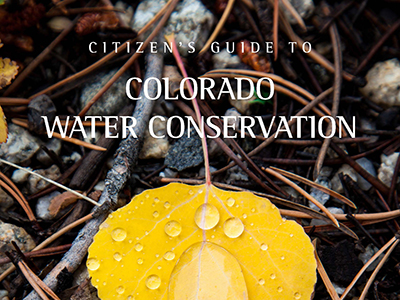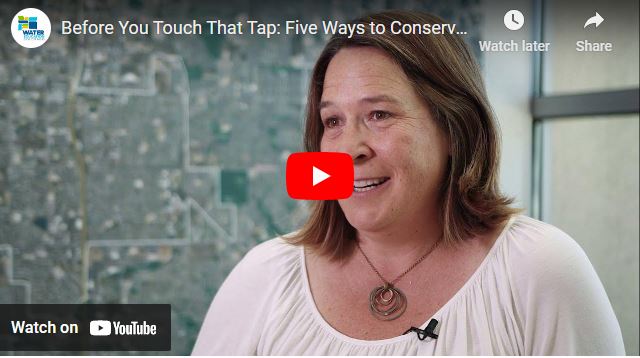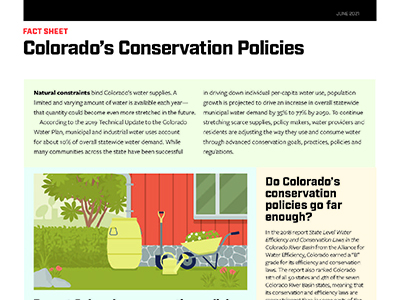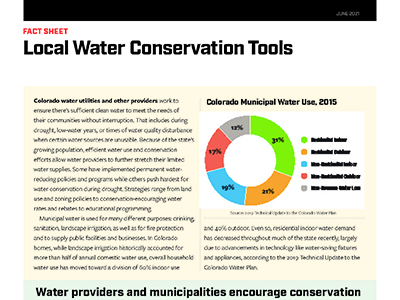Home & Municipal Conservation & Efficiency
Statewide, water conservation efforts have decreased statewide per capita water use by 5% according to the 2023 update to the Colorado Water Plan, but some areas have made greater reductions. These conservation achievements mean that many communities are using less water than they once did, even as they serve growing populations.
Many of the state’s aggressive conservation efforts began during and after 2002, one of the most extreme drought years the state has seen. Municipalities, confronted with the reality of potential supply shortages, turned to outdoor watering restrictions, public education campaigns, adjusted water rates, rebates, and implemented a variety of other best practices to encourage conservation.
Best practices can incentivize and result in water conservation and efficiency. Although many must be implemented by homeowners and business owners themselves, water providers and governments often use a mix of these tools to promote conservation. Strategies include:
Financial Assistance and Incentives
Financial incentives to foster conservation can include rebates for installing efficient plumbing fixtures, appliances and sprinkler heads, and payments or programs for turf removal and replacement with native plants. They can also include water rate structures that encourage conservation where charges escalate as more water is used (called increasing block rates), thus providing an incentive for using less water. Sometimes these tiers are customized based on individual customer needs, or surcharges are added during times of peak demand.
Education and Technical Assistance
Public education efforts raise awareness and foster water-saving behaviors. These include in-classroom programs, water festivals, marketing campaigns, technical water use efficiency mapping, at-home irrigation audits, landscape water budgets, and even the use of smart meters. Smart meters, irrigation audits and water use efficiency mapping all collect real household water use data so that water providers and customers can better understand and improve their water usage. Water use efficiency mapping is used to identify a municipality’s least-efficient customers and encourage them to conserve through audits, rebates, education and other incentives.
Outdoor Watering Rules
Water waste ordinances and watering restrictions are used to discourage wasteful practices, such as watering more frequently than needed, in the heat of the day, on windy days, or with overspray onto non-landscaped zones like pavement. Such restrictions can be enforced by fines, and are often implemented during summer droughts, if not on a permanent basis. A 2020 study by the Alliance for Water Efficiency found that voluntary conservation, where homeowners are asked to cut back on water use or take initiative on their own, doesn’t generate significant water savings but mandatory restrictions reduce annual demand by 18% to 30% and cut monthly peak demand by as much as 42%.
Irrigation System Retrofits & Controls
Each landscape is unique and has individual needs, but an efficient irrigation system will distribute water evenly and ensure that most of the water applied to the landscape is absorbed by the plants being irrigated.
The 2015 Update to GreenCO Literature Review found that the replacement of an inefficient irrigation system resulted in a water savings of about 4.8 gallons per square foot. That study also found that using drip irrigation to infrequently water deep-rooted xeric plants can save 50% to 70% relative to a traditional bluegrass lawn.
Water Efficiency Challenges
Achieving efficient water use in Colorado’s municipalities depends on overcoming a number of challenges. Low water rates present a significant challenge to conservation objectives. Consumers are accustomed to low water prices that often do not adequately account for the full costs of water supply, treatment and distribution.
For water providers to successfully send a price signal to conserve, they may have to identify more dramatic increases between rate blocks. Studies have shown that customers are often relatively unresponsive to small increases in price. At the same time, if a water provider is successful in encouraging customers to conserve, and the volume of their distribution decreases, they may have to raise rates just to continue covering their basic operational costs. Some providers have experienced customer pushback when this happens.
Political reluctance to raise rates can be another challenge for municipally governed water utilities. However, unless there are other perceived reasons to conserve, as long as water is relatively inexpensive the application of more water-efficient technologies and management practices may be limited.
Aging infrastructure is another challenge, forcing water providers to spend more of their budgets on infrastructure repair, replacement and leak detection. These mounting costs on top of the need to allocate more resources to water conservation budgets can present a challenge to water providers as they seek customer buy-in for rate increases.
Water Delivery Systems
Municipal water suppliers can conserve by delivering water efficiently. The 2019 Technical Update to the Colorado Water Plan found that about 12% of municipal water in the state is considered “non-revenue water” meaning that it’s either lost en route to its destination or is not billed for. This includes transmission and distribution system losses, losses from unauthorized water uses, and water that’s unaccounted for due to metering inaccuracies or other errors. Strategies to cut losses include identifying and fixing leaks, maintaining pipelines, installing customer meters to measure the water reaching its destination, and implementing water audits that trace the flow of water through a system to spot and stop leaks.
%
of municipal water, statewide, is lost en route to its destination
Water savings from water loss management programs depend on the level of water loss, which varies between systems. Typically older systems with old pipes and high pressure have greater real losses, or leaks, while systems with old oversized water meters and/or poor accounting practices have greater apparent losses, or water that is actually delivered but not accounted or charged for.
Lowering Water Demand with Rainwater Harvesting, Graywater Reuse and Reuse
When Coloradans make use of rainwater or put water to use a second time, they are able to stretch and conserve water supplies, easing demand on treated water.
Rainwater Harvesting
In 2016, the passage of HB 16-1005 made rainwater harvesting legal in Colorado. Today, precipitation can be collected from residential rooftops provided a maximum of two barrels with a combined storage of 110 gallons or less are used; precipitation is collected from a single-family residence or a building that houses no more than four families; collected water is used on the residential property where it was collected; and that water is used for outdoor purposes like lawn irrigation and gardening.
In addition to providing water for outdoor irrigation—and reducing demand on municipal supplies—rainwater harvesting may increase overall water awareness for residential users, leading to an increased conservation ethic.
Greywater
Making use of greywater is another strategy for efficient consumption of available supply, where allowed. Greywater is water discharged from showers, clothes washers and sinks that is captured, treated, and reused, typically for toilet flushing or outdoor irrigation. It does not involve recirculating water already used for toilets, urinals, kitchen sinks or dishwashers.
In Colorado, greywater may be captured and reused only in regions where local governments have adopted an ordinance approving its use. In 2013, HB 13-1044 authorized the Colorado Department of Public Health and Environment (CDPHE) to develop regulations to ensure the safe use of greywater and allowed local governments to use those rules to establish safe greywater use in their regions. Since 2015, CDPHE’s Regulation 86 and the Colorado Plumbing Board’s adoption of portions of International Plumbing Code have set state regulations around safe greywater reuse.
acre-feet are saved annually for every 1,000 single-family homes equipped with greywater systems, if all greywater produced was used, according to Denver Water
Some homebuilders are pre-piping new homes to be greywater ready, so conversion to utilize greywater should be easier for new development. Potential for this technology also exists in commercial uses, where the economies of scale may make it an easier investment. The widespread installation of greywater systems has not yet occurred in Colorado.
RELATED WECO RESOURCES




